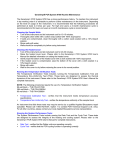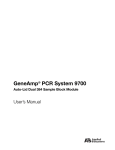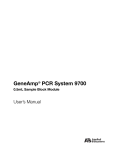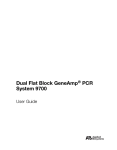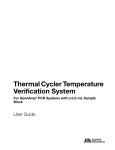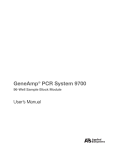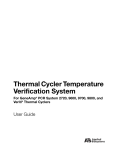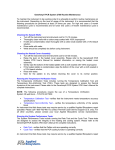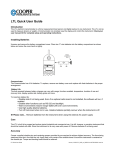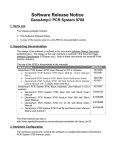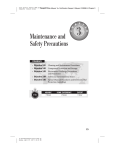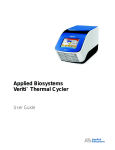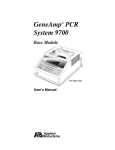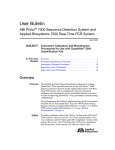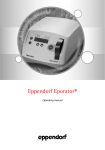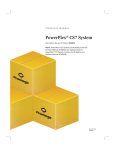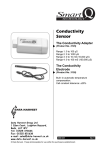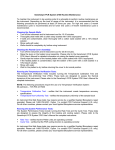Download GeneAmp® PCR System 9700 Dual 96 Sample Block Module
Transcript
GeneAmp® PCR System 9700 Auto-Lid Dual 96 and Dual 96 Sample Block Module User Guide GeneAmp® PCR System 9700 Dual 96 Sample Block Module User Guide © Copyright 2007, 2010 Applied Biosystems. All rights reserved. Information in this document is subject to change without notice. Applied Biosystems assumes no responsibility for any errors that may appear in this document. This document is believed to be complete and accurate at the time of publication. In no event shall Applied Biosystems be liable for incidental, special, multiple, or consequential damages in connection with or arising from the use of this document. The combination of the Dual 96 and Auto-Lid Dual 96 Interchangeable Sample Block Modules with a GeneAmp® PCR System 9700 Base Unit is covered by US patent claims.and counterpart patent claims in other countries. The Auto-lid is covered by US patents. TRADEMARKS: Applera, Applied Biosystems, AB (Design), ABI PRISM, GeneAmp, and MicroAmp are registered trademarks of Applied Biosystems or its subsidiaries in the US and/or certain other countries. All other trademarks are the sole property of their respective owners. Part Number 4343363 Rev. E 06/2010 Contents Preface How to Use This Guide . . . . . . . . . . . . . . . . . . . . . . . . . . . . . . . . . . . . . . . . . . . . . . . . . . . v How to Obtain More Information . . . . . . . . . . . . . . . . . . . . . . . . . . . . . . . . . . . . . . . . . . . . vi How to Obtain Services and Support . . . . . . . . . . . . . . . . . . . . . . . . . . . . . . . . . . . . . . . . vi Safety and EMC Compliance Information Safety Conventions Used in This Document . . . . . . . . . . . . . . . . . . . . . . . . . . . . . . . . . . viii Symbols on Instruments . . . . . . . . . . . . . . . . . . . . . . . . . . . . . . . . . . . . . . . . . . . . . . . . . . ix Safety Labels on Instruments. . . . . . . . . . . . . . . . . . . . . . . . . . . . . . . . . . . . . . . . . . . . . . . x General Instrument Safety . . . . . . . . . . . . . . . . . . . . . . . . . . . . . . . . . . . . . . . . . . . . . . . . . xi Chemical Safety . . . . . . . . . . . . . . . . . . . . . . . . . . . . . . . . . . . . . . . . . . . . . . . . . . . . . . . . xi Chemical Waste Safety . . . . . . . . . . . . . . . . . . . . . . . . . . . . . . . . . . . . . . . . . . . . . . . . . . xiii Chemical Safety . . . . . . . . . . . . . . . . . . . . . . . . . . . . . . . . . . . . . . . . . . . . . . . . . . . . . . . xiv Physical Hazard Safety . . . . . . . . . . . . . . . . . . . . . . . . . . . . . . . . . . . . . . . . . . . . . . . . . . xiv Workstation Safety . . . . . . . . . . . . . . . . . . . . . . . . . . . . . . . . . . . . . . . . . . . . . . . . . . . . . xv Safety and Electromagnetic Compatibility (EMC) Standards . . . . . . . . . . . . . . . . . . . . . xvi Chapter 1 Dual 96 Sample Block Module Overview About the Dual 96 Sample Block Module . . . . . . . . . . . . . . . . . . . . . . . . . . . . . . . . . . . 1-2 Installing the Dual 96 Sample Block Module . . . . . . . . . . . . . . . . . . . . . . . . . . . . . . . . . 1-6 Sample Tray and Plate Configurations . . . . . . . . . . . . . . . . . . . . . . . . . . . . . . . . . . . . . 1-7 Loading Samples . . . . . . . . . . . . . . . . . . . . . . . . . . . . . . . . . . . . . . . . . . . . . . . . . . . . . . 1-9 Chapter 2 Maintaining the Sample Block Module Cleaning the Sample Block Module . . . . . . . . . . . . . . . . . . . . . . . . . . . . . . . . . . . . . . . 2-2 Putting the Heated Cover into Cleaning Position . . . . . . . . . . . . . . . . . . . . . . . . . . . . . 2-2 Cleaning the Heated Cover . . . . . . . . . . . . . . . . . . . . . . . . . . . . . . . . . . . . . . . . . . . . . . 2-3 Cleaning the Sample Block Wells . . . . . . . . . . . . . . . . . . . . . . . . . . . . . . . . . . . . . . . . . 2-3 GeneAmp PCR System 9700 Dual 96 Sample Block Module User Guide iii Chapter 3 Testing the Dual 96 Sample Block Module Performing the Calibration Verification Test . . . . . . . . . . . . . . . . . . . . . . . . . . . . . . . . . . 3-2 Performing the Temperature Non-Uniformity Test . . . . . . . . . . . . . . . . . . . . . . . . . . . . . 3-8 Performing System Performance Diagnostics . . . . . . . . . . . . . . . . . . . . . . . . . . . . . . . 3-15 Index iv GeneAmp PCR System 9700 Dual 96 Sample Block Module User Guide Preface How to Use This Guide Purpose of This Guide Audience Text Conventions The Applied Biosystems GeneAmp® PCR System 9700 Dual 96 Sample Block Module User Guide provides the information you need to operate the Dual 96 Sample Block Module. This guide is intended for novice and experienced GeneAmp® PCR System 9700 users who incorporate the Dual 96 Sample Block module. This guide uses the following conventions: • Bold indicates user action. For example: Type 0, then press Enter for each of the remaining fields. • Italic text indicates new or important words and is also used for emphasis. For example: Before analyzing, always prepare fresh matrix. • A right arrow bracket (>) separates successive commands you select from a drop-down or shortcut menu. For example: Select File > Open > Spot Set. Right-click the sample row, then select View Filter > View All Runs. User Attention Words Two user attention words appear in Applied Biosystems user documentation. Each word implies a particular level of observation or action as described below: Note: Provides information that may be of interest or help but is not critical to the use of the product. IMPORTANT! Provides information that is necessary for proper instrument operation, accurate chemistry kit use, or safe use of a chemical. Examples of the user attention words appear below: Note: The size of the column affects the run time. Note: The Calibrate function is also available in the Control Console. IMPORTANT! To verify your client connection to the database, you need a valid Oracle user ID and password. IMPORTANT! You must create a separate Sample Entry Spreadsheet for each 96-well microtiter plate. Safety Alert Words Safety alert words also appear in user documentation. For more information, see “Safety Alert Words” on page viii. GeneAmp PCR System 9700 Dual 96 Sample Block Module User Guide v Preface How to Obtain More Information Related Documentation The following related documents are shipped with the system: • GeneAmp® PCR System 9700 Base Module User's Manual – Describes the GeneAmp PCR System 9700 hardware and software and provides information on preparing, maintaining, and troubleshooting the system. • GeneAmp® PCR System 9700 Quick Reference Guide Set – The Quick Reference Guide provides the fundamentals of preparing and starting a run and working with methods. Portable document format (PDF) versions of supporting documents are also available on the CD shipped with the system. Note: For additional documentation, see “How to Obtain Services and Support” on page vi. Send Us Your Comments Applied Biosystems welcomes your comments and suggestions for improving its user documents. You can e-mail your comments to: [email protected] How to Obtain Services and Support For the latest services and support information for all locations, go to http://www.appliedbiosystems.com, then click the link for Services and Support. At the Services and Support page, you can: • Search through frequently asked questions (FAQs) • Submit a question directly to Technical Support • Order Applied Biosystems user documents, MSDSs, certificates of analysis, and other related documents • Download PDF documents • Obtain information about customer training • Download software updates and patches In addition, the Services and Support page provides access to worldwide telephone and fax numbers to contact Applied Biosystems Technical Support and Sales facilities. vi GeneAmp PCR System 9700 Dual 96 Sample Block Module User Guide Safety and EMC Compliance Information This section includes the following topics: Safety Conventions Used in This Document . . . . . . . . . . . . . . . . . . . . . . . . . . . . viii Symbols on Instruments . . . . . . . . . . . . . . . . . . . . . . . . . . . . . . . . . . . . . . . . . . . . . . ix Safety Labels on Instruments . . . . . . . . . . . . . . . . . . . . . . . . . . . . . . . . . . . . . . . . . . x General Instrument Safety . . . . . . . . . . . . . . . . . . . . . . . . . . . . . . . . . . . . . . . . . . . . xi Chemical Safety . . . . . . . . . . . . . . . . . . . . . . . . . . . . . . . . . . . . . . . . . . . . . . . . . . . . xi Chemical Waste Safety . . . . . . . . . . . . . . . . . . . . . . . . . . . . . . . . . . . . . . . . . . . . . xiii Electrical Safety . . . . . . . . . . . . . . . . . . . . . . . . . . . . . . . . . . . . . . . . . . . . . . . . . . . xiv Physical Hazard Safety . . . . . . . . . . . . . . . . . . . . . . . . . . . . . . . . . . . . . . . . . . . . . . xiv Workstation Safety . . . . . . . . . . . . . . . . . . . . . . . . . . . . . . . . . . . . . . . . . . . . . . . . . xv Safety and Electromagnetic Compatibility (EMC) Standards . . . . . . . . . . . . . . . . xvi GeneAmp PCR System 9700 Dual 96 Sample Block Module User Guide vii Safety and EMC Compliance Information Safety Conventions Used in This Document Safety Alert Words Four safety alert words appear in Applied Biosystems user documentation at points in the document where you need to be aware of relevant hazards. Each alert word–IMPORTANT, CAUTION, WARNING, DANGER–implies a particular level of observation or action, as defined below: Definitions IMPORTANT! – Indicates information that is necessary for proper instrument operation, accurate chemistry kit use, or safe use of a chemical. – Indicates a potentially hazardous situation that, if not avoided, may result in minor or moderate injury. It may also be used to alert against unsafe practices. – Indicates a potentially hazardous situation that, if not avoided, could result in death or serious injury. – Indicates an imminently hazardous situation that, if not avoided, will result in death or serious injury. This signal word is to be limited to the most extreme situations. Except for IMPORTANTs, each safety alert word in an Applied Biosystems document appears with an open triangle figure that contains a hazard symbol. These hazard symbols are identical to the hazard icons that are affixed to Applied Biosystems instruments (see “Safety Symbols” on page ix). Examples The following examples show the use of safety alert words: IMPORTANT! You must create a separate a Sample Entry Spreadsheet for each 96-well microtiter plate. The lamp is extremely hot. Do not touch the lamp until it has cooled to room temperature. CHEMICAL HAZARD. Formamide. Exposure causes eye, skin, and respiratory tract irritation. It is a possible developmental and birth defect hazard. Read the MSDS, and follow the handling instructions. Wear appropriate protective eyewear, clothing, and gloves. ELECTRICAL HAZARD. Failure to ground the instrument properly can lead to an electrical shock. Ground the instrument according to the provided instructions. viii GeneAmp PCR System 9700 Dual 96 Sample Block Module User Guide Symbols on Instruments Symbols on Instruments Electrical Symbols on Instruments The following table describes the electrical symbols that may be displayed on Applied Biosystems instruments. Symbol Description Indicates the On position of the main power switch. Indicates the Off position of the main power switch. Indicates the On/Off position of a push-push main power switch. Indicates a terminal that may be connected to the signal ground reference of another instrument. This is not a protected ground terminal. Indicates a protective grounding terminal that must be connected to earth ground before any other electrical connections are made to the instrument. Indicates a terminal that can receive or supply alternating current or voltage. Indicates a terminal that can receive or supply alternating or direct current or voltage. Safety Symbols The following table describes the safety symbols that may be displayed on Applied Biosystems instruments. Each symbol may appear by itself or in combination with text that explains the relevant hazard (see “Safety Labels on Instruments” on page x). These safety symbols may also appear next to DANGERS, WARNINGS, and CAUTIONS that occur in the text of this and other product-support documents. Symbol Description Indicates that you should consult the manual for further information and to proceed with appropriate caution. Indicates the presence of an electrical shock hazard and to proceed with appropriate caution. Indicates the presence of a hot surface or other high-temperature hazard and to proceed with appropriate caution. GeneAmp PCR System 9700 Dual 96 Sample Block Module User Guide ix Safety and EMC Compliance Information Symbol Description Indicates the presence of a laser inside the instrument and to proceed with appropriate caution. Indicates the presence of moving parts and to proceed with appropriate caution. Safety Labels on Instruments The following CAUTION, WARNING, and DANGER statements may be displayed on Applied Biosystems instruments in combination with the safety symbols described in the preceding section. English x Francais CAUTION Hazardous chemicals. Read the Material Safety Data Sheets (MSDSs) before handling. ATTENTION Produits chimiques dangeureux. Lire les fiches techniques de sûreté de matériels avant la manipulation des produits. CAUTION Hazardous waste. Read the waste profile (if any) in the site preparation guide for this instrument before handling or disposal. ATTENTION Déchets dangereux. Lire les renseignements sur les déchets avant de les manipuler ou de les éliminer. CAUTION Hazardous waste. Refer to MSDS(s) and local regulations for handling and disposal. ATTENTION Déchets dangereux. Lire les fiches techniques de sûreté de matériels et la régulation locale associées à la manipulation et l'élimination des déchets. WARNING Hot lamp. AVERTISSEMENT Lampe brûlante. WARNING Hot. Replace lamp with an Applied Biosystems lamp. AVERTISSEMENT Composants brûlants. Remplacer la lampe par une lampe Applied Biosystems. CAUTION Hot surface. ATTENTION Surface brûlante. DANGER High voltage. DANGER Haute tension. WARNING To reduce the chance of electrical shock, do not remove covers that require tool access. No user-serviceable parts are inside. Refer servicing to Applied Biosystems qualified service personnel. AVERTISSEMENT Pour éviter les risques d'électrocution, ne pas retirer les capots dont l'ouverture nécessite l'utilisation d'outils. L’instrument ne contient aucune pièce réparable par l’utilisateur. Toute intervention doit être effectuée par le personnel de service qualifié de Applied Biosystems. CAUTION Moving parts. ATTENTION Parties mobiles. GeneAmp PCR System 9700 Dual 96 Sample Block Module User Guide General Instrument Safety General Instrument Safety PHYSICAL INJURY HAZARD. Use this product only as specified in this document. Using this instrument in a manner not specified by Applied Biosystems may result in personal injury or damage to the instrument. Moving and Lifting the Instrument Operating the Instrument PHYSICAL INJURY HAZARD. The instrument is to be moved and positioned only by the personnel or vendor specified in the applicable site preparation guide. If you decide to lift or move the instrument after it has been installed, do not attempt to lift or move the instrument without the assistance of others, the use of appropriate moving equipment, and proper lifting techniques. Improper lifting can cause painful and permanent back injury. Depending on the weight, moving or lifting an instrument may require two or more persons. Ensure that anyone who operates the instrument has: • Received instructions in both general safety practices for laboratories and specific safety practices for the instrument. • Read and understood all applicable Material Safety Data Sheets (MSDSs). See “About MSDSs” on page xi. Chemical Safety Chemical Hazard Warning CHEMICAL HAZARD. Before handling any chemicals, refer to the Material Safety Data Sheet (MSDS) provided by the manufacturer, and observe all relevant precautions. CHEMICAL HAZARD. All chemicals in the instrument, including liquid in the lines, are potentially hazardous. Always determine what chemicals have been used in the instrument before changing reagents or instrument components. Wear appropriate eyewear, protective clothing, and gloves when working on the instrument. About MSDSs Chemical manufacturers supply current Material Safety Data Sheets (MSDSs) with shipments of hazardous chemicals to new customers. They also provide MSDSs with the first shipment of a hazardous chemical to a customer after an MSDS has been updated. MSDSs provide the safety information you need to store, handle, transport, and dispose of the chemicals safely. Each time you receive a new MSDS packaged with a hazardous chemical, be sure to replace the appropriate MSDS in your files. GeneAmp PCR System 9700 Dual 96 Sample Block Module User Guide xi Safety and EMC Compliance Information Obtaining MSDSs You can obtain from Applied Biosystems the MSDS for any chemical supplied by Applied Biosystems. This service is free and available 24 hours a day. To obtain MSDSs: 1. Go to https://docs.appliedbiosystems.com/msdssearch.html 2. In the Search field, type in the chemical name, part number, or other information that appears in the MSDS of interest. Select the language of your choice, then click Search. 3. Find the document of interest, right-click the document title, then select any of the following: • Open – To view the document • Print Target – To print the document • Save Target As – To download a PDF version of the document to a destination that you choose 4. To have a copy of a document sent by fax or e-mail, select Fax or Email to the left of the document title in the Search Results page, then click RETRIEVE DOCUMENTS at the end of the document list. 5. After you enter the required information, click View/Deliver Selected Documents Now. Chemical Safety Guidelines xii To minimize the hazards of chemicals: • Read and understand the Material Safety Data Sheets (MSDS) provided by the chemical manufacturer before you store, handle, or work with any chemicals or hazardous materials. (See “About MSDSs” on page xi.) • Minimize contact with chemicals. Wear appropriate personal protective equipment when handling chemicals (for example, safety glasses, gloves, or protective clothing). For additional safety guidelines, consult the MSDS. • Minimize the inhalation of chemicals. Do not leave chemical containers open. Use only with adequate ventilation (for example, fume hood). For additional safety guidelines, consult the MSDS. • Check regularly for chemical leaks or spills. If a leak or spill occurs, follow the manufacturer’s cleanup procedures as recommended on the MSDS. • Comply with all local, state/provincial, or national laws and regulations related to chemical storage, handling, and disposal. GeneAmp PCR System 9700 Dual 96 Sample Block Module User Guide Chemical Waste Safety Chemical Waste Safety Chemical Waste Hazard Chemical Waste Safety Guidelines Waste Disposal HAZARDOUS WASTE. Refer to Material Safety Data Sheets and local regulations for handling and disposal. To minimize the hazards of chemical waste: • Read and understand the Material Safety Data Sheets (MSDSs) provided by the manufacturers of the chemicals in the waste container before you store, handle, or dispose of chemical waste. • Provide primary and secondary waste containers. (A primary waste container holds the immediate waste. A secondary container contains spills or leaks from the primary container. Both containers must be compatible with the waste material and meet federal, state, and local requirements for container storage.) • Minimize contact with chemicals. Wear appropriate personal protective equipment when handling chemicals (for example, safety glasses, gloves, or protective clothing). For additional safety guidelines, consult the MSDS. • Minimize the inhalation of chemicals. Do not leave chemical containers open. Use only with adequate ventilation (for example, fume hood).For additional safety guidelines, consult the MSDS. • Handle chemical wastes in a fume hood. • After emptying the waste container, seal it with the cap provided. • Dispose of the contents of the waste tray and waste bottle in accordance with good laboratory practices and local, state/provincial, or national environmental and health regulations. If potentially hazardous waste is generated when you operate the instrument, you must: • Characterize (by analysis if necessary) the waste generated by the particular applications, reagents, and substrates used in your laboratory. • Ensure the health and safety of all personnel in your laboratory. • Ensure that the instrument waste is stored, transferred, transported, and disposed of according to all local, state/provincial, and/or national regulations. IMPORTANT! Radioactive or biohazardous materials may require special handling, and disposal limitations may apply. GeneAmp PCR System 9700 Dual 96 Sample Block Module User Guide xiii Safety and EMC Compliance Information Electrical Safety Fuses ELECTRICAL SHOCK HAZARD. Improper fuses or highvoltage supply can damage the instrument wiring system and cause a fire. Before turning on the instrument, verify that the fuses are properly installed and that the instrument voltage matches the power supply in your laboratory. FIRE HAZARD. For continued protection against the risk of fire, replace fuses only with fuses of the type and rating specified for the instrument. Power ELECTRICAL HAZARD. Grounding circuit continuity is vital for the safe operation of equipment. Never operate equipment with the grounding conductor disconnected. ELECTRICAL HAZARD. Use properly configured and approved line cords for the voltage supply in your facility. ELECTRICAL HAZARD. Plug the system into a properly grounded receptacle with adequate current capacity. Overvoltage Rating The GeneAmp PCR System® 9700 system has an installation (overvoltage) category of II, and is classified as portable equipment Physical Hazard Safety Moving Parts PHYSICAL INJURY HAZARD. Moving parts can crush and cut. Keep hands clear of moving parts while operating the instrument. Disconnect power before servicing the instrument. PHYSICAL INJURY HAZARD. Do not operate the instrument without the arm shield in place. Keep hands out of the deck area when the instrument is spotting. Hot Surface xiv PHYSICAL INJURY HAZARD. During instrument operation, the temperature of the heated cover can be as high as 108 °C, and the temperature of the sample block can e as high as 100 °C. Before performing the procedure, keep hands away until the heated cover and sample block reach room temperature. GeneAmp PCR System 9700 Dual 96 Sample Block Module User Guide Workstation Safety Workstation Safety Correct ergonomic configuration of your workstation can reduce or prevent effects such as fatigue, pain, and strain. Minimize or eliminate these effects by configuring your workstation to promote neutral or relaxed working positions. MUSCULOSKELETAL AND REPETITIVE MOTION HAZARD. These hazards are caused by potential risk factors that include but are not limited to repetitive motion, awkward posture, forceful exertion, holding static unhealthy positions, contact pressure, and other workstation environmental factors. To minimize musculoskeletal and repetitive motion risks: • Use equipment that comfortably supports you in neutral working positions and allows adequate accessibility to the keyboard, monitor, and mouse. • Position the keyboard, mouse, and monitor to promote relaxed body and head postures. GeneAmp PCR System 9700 Dual 96 Sample Block Module User Guide xv Safety and EMC Compliance Information Safety and Electromagnetic Compatibility (EMC) Standards This section provides information on: • • • • U.S. and Canadian Safety Standards U.S. and Canadian Safety Standards Canadian EMC Standard European Safety and EMC Standards Australian EMC Standards This instrument has been tested to and complies with standard UL 3101-1, “Safety Requirements for Electrical Equipment for Laboratory Use, Part 1: General Requirements.” This instrument has been tested to and complies with standard CSA 1010.1, “Safety Requirements for Electrical Equipment for Measurement, Control, and Laboratory Use, Part 1: General Requirements.” Canadian EMC Standard European Safety and EMC Standards This instrument has been tested to and complies with ICES-001, Issue 3: Industrial, Scientific, and Medical Radio Frequency Generators. Safety This instrument meets European requirements for safety (Low Voltage Directive 73/23/EEC). This instrument has been tested to and complies with standards EN 61010-1:2001, “Safety Requirements for Electrical Equipment for Measurement, Control and Laboratory Use, Part 1: General Requirements” and EN 61010-2-010, “Particular Requirements for Laboratory Equipment for the Heating of Materials.” EMC This instrument meets European requirements for emission and immunity (EMC Directive 89/336/EEC). This instrument has been tested to and complies with standard EN 61326 (Group 1, Class B), “Electrical Equipment for Measurement, Control and Laboratory Use – EMC Requirements.” Australian EMC Standards xvi This instrument has been tested to and complies with standard AS/NZS 2064, “Limits and Methods Measurement of Electromagnetic Disturbance Characteristics of Industrial, Scientific, and Medical (ISM) Radio-frequency Equipment.” GeneAmp PCR System 9700 Dual 96 Sample Block Module User Guide Dual 96 Sample Block Module Overview 1 1 This chapter covers: About the Dual 96 Sample Block Module . . . . . . . . . . . . . . . . . . . . . . . . . . . . . . Installing the Dual 96 Sample Block Module . . . . . . . . . . . . . . . . . . . . . . . . . . . Sample Tray and Plate Configurations . . . . . . . . . . . . . . . . . . . . . . . . . . . . . . . . . Loading Samples . . . . . . . . . . . . . . . . . . . . . . . . . . . . . . . . . . . . . . . . . . . . . . . . . GeneAmp PCR System 9700 Dual 96 Sample Block Module User Guide DRAFT 1-2 1-6 1-7 1-9 1-1 October 24, 2007 9:40 am, 44343363 D 03 Overview.fm Chapter 1 Dual 96 Sample Block Module Overview About the Dual 96 Sample Block Module What It Does The GeneAmp® PCR System 9700 amplifies nucleic acids using the polymerase chain reaction (PCR) process. Sample block modules are interchangeable. You can, for example, remove a 384-well Sample Block Module and replace it with the Dual 96 Sample Block Module. This interchangeable module design allows you to change sample well formats as well as throughput capacity. Compatible Software Interchanging sample block modules may require a firmware change. If the sample block module is placed on a base module running an earlier software version, the instrument will not operate correctly. To upgrade the base module software, use the floppy disk that is shipped with the Dual 96 Sample Block Module. For instructions on upgrading the software, see the GeneAmp PCR System 9700 Base Module User’s Manual (P/N 4303481) or see “How to Obtain Services and Support”on page vi. Heated Cover The Dual 96 Sample Block Module comes with a heated manual lid. Simply slide the lid back and forth into position. The heated cover slides over the sample blocks and performs two functions: • It raises the temperature of the upper part of the tube (the part above the sample blocks) above the temperature of the reaction mixture. This reduces condensation, which may have a negative effect on your chemistry. • It puts pressure on the reaction plates to seat them firmly and precisely in the sample blocks. This enhances heat transfer. 1-2 DRAFT GeneAmp PCR System 9700 Dual 96 Sample Block Module User Guide October 24, 2007 9:40 am, 44343363 D 03 Overview.fm About the Dual 96 Sample Block Module Module Features The Dual 96 Sample Block Module is shown below (Figure 1-1). Dual 96 Sample Block Module Lever used to move the lid Heated cover Dual 96 sample blocks GR2255 F1 F2 STOP F3 1 Gene PCR Sy Amp ® stem 97 00 F4 2 4 F5 3 5 7 6 8 ENTER POWER 9 0 CE GeneAmp® PCR System 9700 Base Module Figure 1-1 Dual 96 Sample Block Module on the GeneAmp® PCR System 9700 Base Module Sample Blocks There are two sample blocks in the Dual 96 Sample Block Module. Each holds one 96-well reaction plate. IMPORTANT! The right sample block is the primary control block. If you are using only one reaction plate: • Place the reaction plate you are using in the right sample block. • Place an empty reaction plate in the left sample block. Using reaction plates on both sides GeneAmp PCR System 9700 Dual 96 Sample Block Module User Guide If you use just one reaction plate, place it on the right. Place an empty plate on the left. DRAFT 1-3 October 24, 2007 9:40 am, 44343363 D 03 Overview.fm Chapter 1 Dual 96 Sample Block Module Overview Placing the Reaction Plates To place the reaction plates in the sample blocks: 1. Place a 96-well reaction plate into the right sample block. 2. Place a second reaction plate in the left sample block. IMPORTANT! You must insert two plates into the sample block for the instrument to run properly. 3. Close the heated lid: 4. Process the samples. Peltier Heating/ Cooling Unit The internal Peltier heating/cooling unit is housed in the sample block module. The sample block module is made of aluminum to provide the optimal thermal transfer rate. • • • • • Platinum sensors in the sample block module provide: Wide temperature range: 4 to 99.9 °C Accuracy: ±0.25 °C from 35 to 100 °C Uniformity of each sample block: ±0.5 °C (measured after 30 sec at 95 °C) Uniformity of combined sample blocks: ±0.75 °C (measured after 30 sec at 95 °C) • Long-term stability and high reliability Modules, Accessories, and Disposables Ordering The modules listed below are available for the GeneAmp PCR System 9700 Base Module. The accessories and disposables are for use with the Dual 96 Sample Block Module. Order modules, accessories, and disposables from Applied Biosystems by part number. See Tables 1-1 through 1-3. Table 1-1 1-4 Modules for the 9700 Base Module Modules Part Number 96-Well Sample Block Module N805-0251 96-Well Gold Sample Block Module 4314443 DRAFT GeneAmp PCR System 9700 Dual 96 Sample Block Module User Guide October 24, 2007 9:40 am, 44343363 D 03 Overview.fm About the Dual 96 Sample Block Module Table 1-1 Modules for the 9700 Base Module (continued) Modules Part Number 96-Well Aluminum Sample Block Module 4314445 0.5-mL 60-Well Sample Block Module 4309131 Dual 96-Well GeneAmp PCR System 9700 4343176 Dual 384-Well Sample Block Module N805-0400 Table 1-2 Accessories for the 9700 Base Module Accessories Part Number Dual 96-Well Sample Block Module Temperature Verification Kit. 4317939 Dual 384-Well Sample Block Module Temperature Verification Kit 4308354 Tool, 384-Well Plate Extraction T-6273 Table 1-3 Disposables for the 9700 Base Module Disposable Part Number ABI PRISM® 96-Well Optical Reaction Plate 4329989 Adhesive Covers 4311971 MicroAmp® Clear Adhesive Covers 4306311 MicroAmp® Optical 96-Well Reaction Plate N801-0560 MicroAmp® Full Plate Cover N8010550 MicroAmp® Cap Installing Tool N801-0438 MicroAmp® 96-Well Tray/Retainer Sets 403081 MicroAmp® Cap Installing Tool N801-0438 MicroAmp® 96-Well Support Base 4312063 MicroAmp® Reaction Tubes N801-0533 MicroAmp® Caps, Twelve Caps/Strip N801-0534 MicroAmp® Caps, Eight Caps/Strip N801-0535 MicroAmp® Reaction Tubes with Caps N801-0540 MicroAmp® 96-Well Tray for Tubes with Caps N801-0541 MicroAmp® Centrifuge Adapter N801-3822 GeneAmp PCR System 9700 Dual 96 Sample Block Module User Guide DRAFT 1-5 October 24, 2007 9:40 am, 44343363 D 03 Overview.fm Chapter 1 Dual 96 Sample Block Module Overview Installing the Dual 96 Sample Block Module Release Lever A lever behind the sample block module releases it from the GeneAmp® PCR System 9700 Base Module. The top and bottom of the Dual 96 Sample Block Module are shown below. Figure 1-2 Top view, Dual 96 Sample Block Module GR1762 Lever Figure 1-3 Installing the Sample Block Module Bottom view, Dual 96 Sample Block Module To install the sample block module into the GeneAmp PCR System 9700 Base Module: 1. Pull out the lever from the sample block module. 2. Place the sample block module onto the base module, then push the sample block module back to seat the electrical connections. 3. Push the lever into the base module to secure the sample block module. Note: If the sample block module is not seated correctly, the instrument cannot be turned on. 1-6 DRAFT GeneAmp PCR System 9700 Dual 96 Sample Block Module User Guide October 24, 2007 9:40 am, 44343363 D 03 Overview.fm Sample Tray and Plate Configurations Sample Tray and Plate Configurations The following section describes the possible sample tray and plate configurations. IMPORTANT! The Tray or the Tray Retainer Set are essential for the operation of the GeneAmp PCR System 9700.Sample Tray and Plate Configurations Table 1-4 illustrates the possible sample tray and plate configurations. Table 1-4 Sample tray and plate configurations With this vessel... MicroAmp Optical 96-Well Reaction Plate Use... As Shown Adhesive cover Adhesive cover MicroAmp Optical 96Well Reaction Plate MicroAmp 96-Well Support Base MicroAmp 96-Well Full Plate Cover MicroAmp 96-Well Full Plate Cover MicroAmp Optical 96-Well Reaction Plate GR2250 MicroAmp 96-Well Support Base MicroAmp 8-Strip Caps MicroAmp Caps, 8-Strip GR2251 MicroAmp Optical 96-Well Reaction Plate GeneAmp PCR System 9700 Dual 96 Sample Block Module User Guide MicroAmp 96-Well Support Base DRAFT 1-7 October 24, 2007 9:40 am, 44343363 D 03 Overview.fm Chapter 1 Dual 96 Sample Block Module Overview Table 1-4 Sample tray and plate configurations (continued) With this vessel... MicroAmp Reaction Tubes with Caps Use... As Shown MicroAmp 96-Well Tray for Tubes with Caps MicroAmp Reaction Tubes with Caps GR2252 MicroAmp 96-Well Tray for Tubes with Caps MicroAmp 8-Strip Tubes or Single Tubes MicroAmp 96-Well Tray Retainer Set MicroAmp 8-Strip Caps MicroAmp 96-Well Support Base MicroAmp Caps, 8-Strip MicroAmp 96-Well Retainer MicroAmp 8-Strip Tubes or Single Tubes GR2253 MicroAmp 96-Well Tray MicroAmp 96-Well Full Plate Cover MicroAmp 96-Well Support Base MicroAmp 96-Well Full Plate Cover MicroAmp 96-Well Retainer MicroAmp 8-Strip Tubes or Single Tubes GR2254 MicroAmp 96-Well Tray 1-8 DRAFT MicroAmp 96-Well Support Base GeneAmp PCR System 9700 Dual 96 Sample Block Module User Guide October 24, 2007 9:40 am, 44343363 D 03 Overview.fm Loading Samples Loading Samples The following procedures describe how to load samples for: • • • • Tubes with attached caps 96-Well reaction plate 96-Well Tray Retainer Assembly Sample volume range: 5 to 100 µL in “D96” mode IMPORTANT! Do not use mineral oil or glycerine in the sample block or as a vapor barrier over the PCR reaction mixture in the tubes. The MicroAmp Reaction Tubes fit tightly in the wells and a heated cover exerts even pressure on all tubes, reducing condensation on the tubes when you are using a tray or tray/retainer set. Loading Tubes with Attached Caps To load tubes with attached caps: 1. Set the 96-well tray on a 96-well support base. 2. Place the reaction tubes in the tray. 3. Pipette the samples into the reaction tubes. 4. Cap the tubes. Loading the 96-Well Reaction Plate To load the 96-well reaction plate: 1. Place the reaction plate on the 96-well support base. 2. Pipette the samples into the sample wells. 3. Apply the adhesive cover with a compression pad or cap the tubes using either the MicroAmp 96-Well Full Plate Cover or the MicroAmp 8-Strip Caps. Loading the 96-Well Tray Retainer Assembly To load the 96-Well Tray Retainer Assembly: 1. Place the tray on the 96-well support base. 2. Load tubes onto the tray, either using single tubes or using the 8-well tubes. 3. Place retainer over the tubes. 4. Pipette the samples into the tubes. 5. Cap the tubes using either the MicroAmp 96-Well Full Plate Cover or the MicroAmp 8-Strip Caps. GeneAmp PCR System 9700 Dual 96 Sample Block Module User Guide DRAFT 1-9 October 24, 2007 9:40 am, 44343363 D 03 Overview.fm Chapter 1 Dual 96 Sample Block Module Overview Placing the Sample Tray or Plate onto the Block To place a sample tray or plate onto the block: 1. Lift the sample tray from the 96-well base and place it in the sample block. Place the MicroAmp tray or plate so that well H12 is located at the upper right corner of the tray. A B C D E F G H 1 H12 2 3 4 5 6 7 8 9 10 11 12 GR1070 Figure 1-4 Align well H12 with upper right corner of the tray IMPORTANT! Do not place the base into the sample block. 2. Slide the heated cover forward. Note: Ensure that the cover is pulled completely forward for a proper seal. 3. Pull the heated cover lever down to engage the heated cover with the reaction plate. 4. Process the samples IMPORTANT! Do not open the cover when the block temperature is above 27 °C because sample caps may pop off or jam. 1-10 DRAFT GeneAmp PCR System 9700 Dual 96 Sample Block Module User Guide October 24, 2007 9:40 am, 44343363 D 03 Overview.fm Maintaining the Sample Block Module 2 2 This chapter covers: Cleaning the Sample Block Module . . . . . . . . . . . . . . . . . . . . . . . . . . . . . . . . . . . . 2-2 Putting the Heated Cover into Cleaning Position . . . . . . . . . . . . . . . . . . . . . . . . . . 2-2 Cleaning the Heated Cover . . . . . . . . . . . . . . . . . . . . . . . . . . . . . . . . . . . . . . . . . . . 2-3 Cleaning the Sample Block Wells . . . . . . . . . . . . . . . . . . . . . . . . . . . . . . . . . . . . . 2-3 GeneAmp PCR System 9700 Dual 96 Sample Block Module User Guide 2-1 Chapter 2 Maintaining the Sample Block Module Cleaning the Sample Block Module Overview The following procedures describe how to: • Put the heated cover into the cleaning position • Clean the heated cover • Clean the sample block wells Before using any cleaning or decontamination method, except those recommended in this manual, check with Applied Biosystems to ensure that the proposed method will not damage the equipment. Required Materials To clean the system, you need: • • • • Bleach, 10% Isopropanol, pure Cotton swabs Clean cloth CHEMICAL HAZARD. Sodium hypochlorite (bleach) is a liquid disinfectant that can be corrosive to the skin and can cause skin depigmentation. Please read the MSDS, and follow the handling instructions. Wear appropriate protective eyewear, clothing, and gloves. CHEMICAL HAZARD. Isopropanol is a flammable liquid and vapor. It may cause eye, skin, and upper respiratory tract irritation. Prolonged or repeated contact may dry skin and cause irritation. It may cause central nervous system effects such as drowsiness, dizziness, and headache, etc. Please read the MSDS, and follow the handling instructions. Wear appropriate protective eyewear, clothing, and gloves. Putting the Heated Cover into Cleaning Position Clean the heated cover at least once a month or more frequently, if needed. During instrument operation, the temperature of the heated cover can be as high as 108 °C, and the temperature of the sample block module can be as high as 100 °C. Before performing this procedure, wait until the heated cover and sample block module reach room temperature. To put the heated cover into cleaning position: 1. Power off the instrument. 2. Unplug the instrument. 3. Wait 20–30 minutes for the heated cover to cool down. 2-2 GeneAmp PCR System 9700 Dual 96 Sample Block Module User Guide Cleaning the Heated Cover 4. Put the cover into the cleaning position by raising the front of the lid through the slots on each side of the module as shown in Figure 2-1. Raise front of the lid up through the slots Slot Slot GR2255 F1 F2 STOP F3 1 Gene PCR Sy Amp ® stem 97 00 F4 2 4 F5 3 5 7 6 8 ENTE R POWE R 9 0 CE Figure 2-1 Heated cover in cleaning position Cleaning the Heated Cover To clean the heated cover 1. Soak a cotton swab or clean cloth with pure isopropanol and gently wipe the bottom of the heated cover. CHEMICAL HAZARD. Isopropanol is a flammable liquid and vapor. It may cause eye, skin, and upper respiratory tract irritation. Prolonged or repeated contact may dry skin and cause irritation. It may cause central nervous system effects such as drowsiness, dizziness, and headache, etc. Please read the MSDS, and follow the handling instructions. Wear appropriate protective eyewear, clothing, and gloves. 2. If the heated cover becomes contaminated with amplified DNA: a. Wipe the heated cover with a clean cloth or cotton swab soaked in 10% bleach. b. Wipe with a clean, damp cloth. 3. Remove any remaining isopropanol from the heated cover with a clean cloth and return the cover to its normal position. Cleaning the Sample Block Wells Clean the sample block wells once a month or more frequently, if needed. GeneAmp PCR System 9700 Dual 96 Sample Block Module User Guide 2-3 Chapter 2 Maintaining the Sample Block Module To clean the sample block wells: 1. Let the system 9700 cool to the idle setpoint (25 °C). 2. Put the heated cover into the cleaning position. See step 4 on page 2-3 and Figure 2-1 above. 3. Power off the instrument. 4. Unplug the instrument. 5. Remove the reaction plates from the sample block module and set them aside. 6. Soak a cotton swab in pure isopropanol and clean the sample block wells thoroughly. 7. Remove any remaining isopropanol from the sample block before reloading the reaction plates. 8. If the sample block wells become contaminated with amplified DNA: a. Clean the wells thoroughly with a cotton swab soaked in 10% bleach. b. Wipe with a clean, damp cloth. c. CHEMICAL HAZARD. Sodium hypochlorite (bleach) is a liquid disinfectant that can be corrosive to the skin and can cause skin depigmentation. Please read the MSDS, and follow the handling instructions. Wear appropriate protective eyewear, clothing, and gloves. 2-4 GeneAmp PCR System 9700 Dual 96 Sample Block Module User Guide Testing the Dual 96 Sample Block Module 3 3 This chapter covers: Performing the Calibration Verification Test . . . . . . . . . . . . . . . . . . . . . . . . . . . . 3-2 Performing the Temperature Non-Uniformity Test . . . . . . . . . . . . . . . . . . . . . . . 3-8 Performing System Performance Diagnostics. . . . . . . . . . . . . . . . . . . . . . . . . . . 3-15 GeneAmp PCR System 9700 Dual 96 Sample Block Module User Guide 3-1 Chapter 3 Testing the Dual 96 Sample Block Module Performing the Calibration Verification Test Overview Use this test to verify the temperature calibration of the GeneAmp® PCR System 9700 Dual 96 Sample Block Module. To complete the Calibration Verification Test, you perform the following tasks, in order: Tasks See Page Setting Up the 0.2-mL Probe Assembly 3-3 Configuring the System 9700 3-3 Performing the Calibration Verification Test 3-4 Evaluating the Results 3-6 Ending the Test 3-6 In this procedure, you use the digital thermometer to take temperature readings of one sample well connected to the 0.2-mL Probe Assembly. You take a reading at two setpoint temperatures, 85 °C and 45 °C. PHYSICAL INJURY HAZARD. Hot Surface. Use care when working around the heated cover and sample block to avoid being burned by hot components. Note: To exit the test at any time, press F5 (Cancel). Required Materials This test requires the Temperature Verification System, Dual 0.2 mL (P/N 4346117), which includes: • • • • • 3-2 Light mineral oil Cotton swabs Temperature Verification Plates 0.2-mL Probe Assembly Digital thermometer with 9 V battery installed GeneAmp PCR System 9700 Dual 96 Sample Block Module User Guide Performing the Calibration Verification Test Setting Up the 0.2-mL Probe Assembly To set up the 0.2-mL Probe Assembly: 1. If the heated cover is in the forward position, lift the lever, then slide the heated cover back. 2. Position the 9700 Temperature Verification Plates on the appropriate sample blocks: • Right sample block – Plate labeled with R1 to R6 • Left sample block – Plate labeled with L1 to L6 Position the plate with the notch facing the back of the instrument. Note: The plates are used as a guide to help you locate the probes within the sample blocks. 3. Using a cotton swab, coat well R3 with mineral oil. 4. Place the 0.2-mL Probe Assembly into well R3. 5. Thread the probe wire through the channel in the Temperature Verification Plate to prevent damage to the probe and lead wires. 6. Make sure the probe is connected to the digital thermometer. 7. Slide the heated cover forward and pull the lever down. IMPORTANT! Seat the probe properly and close the heated cover carefully. If the probe wire is crushed when the heated cover is closed, the probe may be damaged. 8. Power on the digital thermometer. Note: Refer to the instructions included with the Temperature Verification System for a detailed description on operating the digital thermometer. 9. Continue with “Configuring the System 9700” on page 3-3. Configuring the System 9700 Before you begin configuring the System 9700, perform the procedure described in “Setting Up the 0.2-mL Probe Assembly” on page 3-3. To configure the System 9700 for the Calibration Verification Test: 1. Power on the System 9700. The Main menu is displayed. 2. Press F4 (Util). The Utilities screen is displayed. 3. Press F1 (Diag). The Diagnostics screen is displayed. 4. Press F3 (TmpVer). The Temperature Verification screen is displayed. Temperature Verification Temp - Calibration Verification TNU - Temperature Non-Uniformity Temp TNU F1 F2 Exit F3 GeneAmp PCR System 9700 Dual 96 Sample Block Module User Guide F4 F5 3-3 Chapter 3 Testing the Dual 96 Sample Block Module 5. Press F1 (Temp). The Calibration Verification screen is displayed and the System 9700 is automatically configured for the Calibration Verification Test. Calibration Verification Block temp = xx.x°C Cover temp = xxx°C Place probe in well R3 Press Run Run F1 Cancel F2 F3 F4 F5 6. Continue with “Performing the Calibration Verification Test” on page 3-4. Performing the Calibration Verification Test Before you begin calibrating the System 9700, • Perform the procedures in: – “Setting Up the 0.2-mL Probe Assembly” on page 3-3 – “Configuring the System 9700” on page 3-3 • Obtain the current Calibration Verification Data Sheet for your system, or copy the form on page 3-7. To perform the Calibration Verification Test: 1. Press F1 (Run). The Calibration Verification screen is displayed for the first setpoint, 85 °C. Calibration Verification Block temp = xx.x°C Cover temp = xxx°C Setpoint is 85°C Cover must be within 1°C of 105°C Cancel F1 F2 F3 F4 F5 The System 9700 ramps up the lid temperature (cover temp) to 105 °C (±1 °C). It may take several minutes for the System 9700 to ramp up. When the lid temperature is reached, the “Stabilizing at setpoint” screen is displayed. The “Stabilizing at setpoint” value begins to count down. Calibration Verification Block temp = xx.x°C Cover temp = xxx°C Stabilizing at setpoint x:xx Cancel . F1 F2 F3 F4 F5 2. When the “Stabilizing at setpoint” value decrements to zero, read the digital thermometer. Refer to the instructions included with the Temperature Verification System for a detailed description on operating the digital thermometer. 3-4 GeneAmp PCR System 9700 Dual 96 Sample Block Module User Guide Performing the Calibration Verification Test 3. Using the numeric keys, type the value displayed on the digital thermometer in the “Enter actual block temperature” field. Calibration Verification Block temp = xx.x°C Cover temp = xxx°C Enter actual block temperature xx.x Cancel F1 F2 F3 F4 F5 Note: The digital thermometer displays a four-digit value; round off the value to three digits before typing it in the Calibration Verification screen. Record the value on the Calibration Verification Test Data Sheet (page 3-7). 4. Press Enter. The System 9700 automatically begins the second reading. The Calibration Verification screen is displayed for the second setpoint, 45 °C. If necessary, the System 9700 ramps up the lid temperature (cover temp) to 105 °C (±1 °C) before initiating the “Stabilizing at setpoint” value countdown. Calibration Verification Block temp = xx.x°C Cover temp = xxx°C Setpoint is 45°C Cover must be within 1°C of 105°C Cancel F1 F2 F3 F4 F5 5. When the “Stabilizing at setpoint” value decrements to zero, read the digital thermometer and enter the value for the second reading as described in steps 2 and 3. Record the value. The System 9700 evaluates the calibration of the sample block temperature for the setpoint values you entered and displays the results. A summary screen is displayed at the conclusion of the test. Calibration Verification Actual temperature at 85 °C Actual temperature at 45 °C xx.x xx.x Cancel Accept F1 F2 F3 F4 F5 Compare the values displayed with the actual test results you recorded. If the values differ, repeat the procedure to make sure you entered the values accurately. 6. If the values agree, press F1 (Accept). 7. Continue with “Evaluating the Results” on page 3-6 and “Ending the Test” on page 3-6. GeneAmp PCR System 9700 Dual 96 Sample Block Module User Guide 3-5 Chapter 3 Testing the Dual 96 Sample Block Module Evaluating the Results Table 3-1 When the System 9700 completes the Calibration Verification Test, one of two screens is displayed (Table 3-1) to evaluate the results. Calibration Verification Test Results If the screen displays… Then the sample block module... Is properly calibrated Calibration Verification Calibration is good Exit F1 F2 F3 F4 F5 Failed the Calibration Verification Test Calibration Verification Instrument may require service. Contact Applied Biosystems Technical Support. Exit F1 F2 Ending the Test F3 F4 F5 • Repeat the procedure to make sure you accurately read and entered the temperature readings. • If the test fails again, contact Applied Biosystems Technical Support. For information, see “How to Obtain Services and Support” on page vi. To end the test: 1. Press F5 (Exit). Continue to press F5 (Exit) until the Main Menu screen is displayed. 2. Remove the 0.2-mL Probe Assembly from the sample block. 3. Power off the digital thermometer and clean off the oil. 4. Wait for the sample block to reach room temperature (~25 °C), then remove the 96-Well Temperature Verification Plates from the sample blocks. 5. Clean the oil from the sample block. 3-6 GeneAmp PCR System 9700 Dual 96 Sample Block Module User Guide Performing the Calibration Verification Test Data Sheet: Calibration Verification Test When you run the Calibration Verification Test, record the setpoint values for well R3 on a copy of the data sheet. At the end of the Calibration Verification Test, check the values displayed on the System 9700 against the values recorded to ensure accurate test records. IMPORTANT! Use a photocopy of this page to record values, and keep the original intact. . Date Tested By Probe Serial No. Thermometer Serial No. GeneAmp PCR System 9700 Dual 96 Sample Block Module User Guide Setpoint Value: Well R3 85 °C 45 °C 3-7 Chapter 3 Testing the Dual 96 Sample Block Module Performing the Temperature Non-Uniformity Test Overview Use this test to find wells within the GeneAmp PCR System 9700 Dual 96-Well Sample Block Module that exhibit unacceptable temperature variation. To complete the Temperature Non-Uniformity Test, you perform the following tasks, in order: Tasks See Page Setting Up the 0.2-mL Probe Assembly 3-8 Configuring the System 9700 3-9 Performing the Temperature Non-Uniformity Test 3-9 Evaluating the Results 3-13 Ending the Test 3-13 The Temperature Non-Uniformity Test uses the 0.2-mL Probe Assembly to test the temperature uniformity of all six wells in the left and right sample blocks. You test each well at two setpoints, 95 °C and 55 °C. PHYSICAL INJURY HAZARD. Hot Surface. Use care when working around the heated cover and sample block to avoid being burned by hot components. Note: To exit the test at any time, press F5 (Cancel). Required Materials Setting Up the 0.2-mL Probe Assembly See “Required Materials” on page 3-2 for information. To set up the 0.2-mL Probe Assembly: 1. If the heated cover is in the forward position, lift the lever, then slide the heated cover back. 2. Position the Temperature Verification Plates on the appropriate sample blocks: • Right sample block – Plate labeled with R1 to R6 • Left sample block – Plate labeled with L1 to L6 Position the plate with the notch facing the back of the instrument. Note: The plates are used as a guide to help you locate the probes within the sample blocks. 3. Using a cotton swab, coat wells R1 to R6 and L1 to L6 with mineral oil. 4. Place the 0.2-mL Probe Assembly into the well to be tested. Begin testing with well L1. 5. Thread the probe wire through the channel in the Temperature Verification Plate to prevent damage to the probe and lead wires. 6. Make sure the probe is connected to the digital thermometer. 3-8 GeneAmp PCR System 9700 Dual 96 Sample Block Module User Guide Performing the Temperature Non-Uniformity Test 7. Slide the heated cover forward and pull the lever down. IMPORTANT! Seat the probe properly and close the heated cover carefully. If the probe wire is crushed when the heated cover is closed, the probe may be damaged. 8. Power on the digital thermometer. Note: Refer to the instructions included with the Temperature Verification System for a detailed description on operating the digital thermometer. 9. Continue with “Configuring the System 9700” on page 3-9. Configuring the System 9700 Before you begin configuring the System 9700, perform the procedures described in “Setting Up the 0.2-mL Probe Assembly” on page 3-8. To configure the System 9700 for the Calibration Verification Test: 1. Power on the System 9700. The Main menu is displayed. 2. Press F4 (Util). The Utilities screen is displayed. 3. Press F1 (Diag). The Diagnostics screen is displayed. 4. Press F3 (TmpVer). The Temperature Verification screen is displayed. Temperature Verification Temp - Calibration Verification TNU - Temperature Non-Uniformity Temp TNU F1 F2 Exit F3 F4 F5 5. Press F2 (TNU). The TNU Performance setpoint screen is displayed and the system is automatically configured for the Temperature Non-Uniformity Test. When the configuration is complete, the TNU Performance probe position screen is displayed. TNU Performance Sample temp = xx.x°C Cover temp = xxx°C Place Probe in well L1 Press Run Run F1 Cancel F2 F3 F4 F5 6. Continue with “Performing the Temperature Non-Uniformity Test” on page 3-9. Performing the Temperature Non-Uniformity Test Before you begin the Temperature Non-Uniformity Test: • Perform the procedures in: – “Setting Up the 0.2-mL Probe Assembly” on page 3-8 – “Configuring the System 9700” on page 3-9 • Obtain the current Temperature Uniformity Data Sheet for your system, or copy the form on page 3-14. GeneAmp PCR System 9700 Dual 96 Sample Block Module User Guide 3-9 Chapter 3 Testing the Dual 96 Sample Block Module To perform the Temperature Non-Uniformity Test: 1. Press F1 (Run). This starts the Temperature Non-Uniformity Test. The TNU Performance screen is displayed with the first setpoint value, 95 °C. TNU Performance Sample temp = xx.x°C Cover temp = xxx°C Setpoint is 95°C Sample must be within 1.0°C of setpoint Cancel F1 F2 F3 F4 F5 If necessary, the System 9700 ramps up the sample block (sample temp) and lid (cover temp) temperatures to the specified values. It may take several minutes for the System 9700 to stabilize at these temperature. When the sample block and lid temperatures are reached, the “Stabilizing at setpoint” screen is displayed. The TNU Performance screen counts down the time until the setpoint is stabilized. TNU Performance Sample temp = xx.x°C Cover temp = xxx°C Stabilizing at setpoint x:xx Cancel F1 F2 F3 F4 F5 2. When the “Stabilizing at setpoint” value decrements to zero, read the digital thermometer. Refer to the instructions included with the Temperature Verification System for a detailed description on operating the digital thermometer. 3-10 GeneAmp PCR System 9700 Dual 96 Sample Block Module User Guide Performing the Temperature Non-Uniformity Test 3. Using the numeric keys, type the value displayed on the digital thermometer in the “Enter actual block temperature” field. TNU Performance Sample temp = xx.x°C Cover temp = xxx°C Enter actual block temperature 00.0 Cancel F1 F2 F3 F4 F5 Note: The digital thermometer displays a four-digit value; round off the value to three digits before typing it in the Calibration Verification screen. Record the value and well number on the Temperature Non-Uniformity Test Data Sheet (page 3-14). 4. Press Enter. The System 9700 automatically begins the second reading.The TNU Performance screen is displayed for the second setpoint, 55 °C. If necessary, the System 9700 ramps up the sample and lid (cover temp) temperatures to the specified values before initiating the “Stabilizing at setpoint” value countdown. TNU Performance Sample temp = xx.x°C Cover temp = xxx°C Setpoint is 55°C Sample must be within 1.0°C of setpoint Cancel F1 F2 F3 F4 F5 5. When the “Stabilizing at setpoint” value decrements to zero, read the digital thermometer and enter the value for the second reading as described in steps 2 and 3. Record the value. 6. Press Enter. The TNU Performance screen is displayed with the following message: TNU Performance Sample temp = xx.x°C Cover temp = xxx°C Place probe in well xx Press Run Run F1 Cancel F2 F3 GeneAmp PCR System 9700 Dual 96 Sample Block Module User Guide F4 F5 3-11 Chapter 3 Testing the Dual 96 Sample Block Module 7. Test the next well: a. Move the probe assembly to the next well – Slide the heated lid back. Move the probe. Make sure the probe is connected to the digital thermometer. Seat the probe and close the cover. See “Setting Up the 0.2-mL Probe Assembly” on page 3-8, steps 4 through 6. b. Initiate and enter the first setpoint reading – Press F1 (Run). Repeat steps 2 and 3 of this procedure. c. Initiate and enter the second setpoint reading – Press Enter. Repeat steps 2 and 3 of this procedure. 8. To initiate testing of the next well, press Enter. 9. Repeat steps 7 and 8 of this procedure until you test all 12 wells (L1 to L6 and R1 to R6). 10. After the last well is tested, the System 9700 displays the values you entered. Well L1 L2 L3 L4 Accept F1 95°C xx.x xx.x xx.x xx.x F2 55°C xx.x xx.x xx.x xx.x Well L5 L6 R1 R2 More F3 95°C 55°C xx.x xx.x xx.x xx.x xx.x xx.x xx.x xx.x Cancel F4 F5 Compare the values displayed with the actual test results you recorded on the Temperature Non-Uniformity Test Data Sheet. If the values differ, repeat the procedure to make sure the values were accurately entered. 11. If the values agree, press F1 (Accept). 12. Continue with “Evaluating the Results” on page 3-13 and “Ending the Test” on page 3-13. 3-12 GeneAmp PCR System 9700 Dual 96 Sample Block Module User Guide Performing the Temperature Non-Uniformity Test Evaluating the Results When the System 9700 completes the Temperature Non-Uniformity Test, the TNU Performance screen is displayed. See the table below to evaluate the results. If the performance result displays… Then… Pass after both setpoint temperatures The temperature of the sample block wells is uniform. “Fail” after one or both setpoints The temperature variation of the sample block wells is unacceptable. • Repeat the procedure to make sure you accurately read and entered the temperature readings. • If the test fails again, contact Applied Biosystems Technical Support. See “How to Obtain Services and Support” on page vi. Ending the Test To end the test, follow the procedures in “Ending the Test” on page 3-6. GeneAmp PCR System 9700 Dual 96 Sample Block Module User Guide 3-13 Chapter 3 Testing the Dual 96 Sample Block Module Data Sheet: Temperature Non-Uniformity Test When you run the Temperature Non-Uniformity Test, record the setpoint values for wells L1–L6 and R1–R6 on a copy of this data sheet. At the end of the Temperature Non-Uniformity Test, check the values displayed on the System 9700 against the values recorded to ensure accurate test records. IMPORTANT! Use a photocopy of this page to record values, and keep the original intact. Date Tested By Probe Serial No. Meter Serial No. Setpoint Value 95 °C 55 °C L1 L2 L3 L4 L5 L6 R1 R2 R3 R4 R5 R6 3-14 GeneAmp PCR System 9700 Dual 96 Sample Block Module User Guide Performing System Performance Diagnostics Performing System Performance Diagnostics After you have configured the GeneAmp PCR System 9700, conduct the system Rate and Cycle performance tests to verify the integrity of the cooling and heating system. IMPORTANT! Before you begin these tests, make sure that you place an empty 96-well plate with full plate lid on the sample block (or use an empty tray and lid the wells with caps or the full plate cover). Slide the heated lid forward, and pull the lever down. Accessing the Tests To access the tests, press System from the Diagnostics screen. The System Performance screen is displayed. System Performance Rate - Cool and Heat Rate Test Cycle - Cycle Performance Test Performing the Rate Test Rate Cycle F1 F2 Exit F3 F4 F5 Use the Rate Test to verify that the Peltier units are operating correctly. The test takes approximately two minutes to run. IMPORTANT! Ambient Temperature Conditions: Cool and Heat Rate tests provide accurate results only if the normal operating ambient temperature is 15 to 24°C. To perform the Rate Test: 1. Press Rate in the System Performance screen. If appropriate, the following reminder is displayed. WARNING!!! Install the appropriate empty Consumables into the Sample Block. Refer to System Performance Section of the Block User Manual. Cancel Cont F1 F2 F3 F4 F5 2. After you have installed a plate and lid, press Cont. The instrument then runs through a series of tests where the sample block is stabilized at 35 °C, 94 °C, and 4 °C. At the conclusion of the test, the Cool and Heat Test screen is displayed. The screen displays the test results and whether the test results passed or failed. GeneAmp PCR System 9700 Dual 96 Sample Block Module User Guide 3-15 Chapter 3 Testing the Dual 96 Sample Block Module Cool and Heat Rate Test Pass Heating rate: x.xx °C/s Cooling rate: x.xx °C/s Cancel Print F1 F2 F3 F4 F5 The passing ranges for the Rate Test are: Performing the Cycle Test Block Type Heating Rate Cooling Rate Dual 96-well > 0.70 °C/second > 1.4 °C/second Use the Cycle Test to verify that the PCR cycling function operates properly. This test takes approximately 15 minutes to run. To perform the Cycle Test: 1. Press Cycle from the System Performance screen. This runs the Cycle Test. If appropriate, the following reminder is displayed. WARNING!!! Install the appropriate empty Consumables into the Sample Block. Refer to System Performance Section of the Block User Manual. Cancel Cont F1 F2 F3 F4 F5 2. After you have installed a plate cover, press Cont. The Cycle Test executes a standard PCR cycling reaction, measures, and reports the average cycle time, and the cycle to cycle variation. IMPORTANT! Pressing Pause during the Cycle Test may generate false test results. Re-run the Cycle Test if Pause is pressed during the test. 3. At the conclusion of the test, the display indicates test results and whether the test results passed or failed. Cycle Performance Pass Average Cycle Time: xxx.x sec x.x sec Cycle Time STD: Print F1 Cancel F2 F3 F4 F5 The following table lists the passing ranges for the Cycle Test. Average Cycle Time 3-16 <= 160 sec. GeneAmp PCR System 9700 Dual 96 Sample Block Module User Guide Performing System Performance Diagnostics Cycle Time STD < 5 sec. GeneAmp PCR System 9700 Dual 96 Sample Block Module User Guide 3-17 Chapter 3 Testing the Dual 96 Sample Block Module 3-18 GeneAmp PCR System 9700 Dual 96 Sample Block Module User Guide Index Numerics 0.2-µL Probe Assembly, setting up Temperature Non-Uniformity Test 3-8 96-Well Sample Block Module, part number 1-4, 1-5 96-well sample plate loading 1-10 sample tray configurations 1-8, 1-9 A Accessories, ordering 1-4 Applied Biosystems contacting vi customer feedback on documentation Services and Support vi Technical Communications vi Technical Support vi Australian EMC standards xvi vi B biohazardous waste, handling bold text, when used v italic text v menu commands v Notes v user attention words v conventions, safety viii cooling information 1-4 verifying cooling system 3-15 customer feedback, on Applied Biosystems documents vi Cycle Test accessing 3-15 running 3-16 xiii C Calibration Verification Test 3-2 to 3-6 data sheet 3-7 discontinuing 3-2 exiting 3-2 required materials 3-2 Canadian safety standards xvi CAUTION description viii example viii chemical safety xi chemical safety guidelines xii chemical waste hazards xiii safety xiii safety guidelines xiii chemical waste disposal, guidelines xiii cleaning the sample block module 2-2, 2-4 conventions bold text v IMPORTANTS! v in this guide v D DANGER description viii example viii data sheet Calibration Verification Test 3-7 Temperature Non-Uniformity Test 3-14 diagnostics 3-15, 3-16 accessing the tests 3-15 Cycle Test, running 3-16 Rate Test, running 3-15, 3-16 diagrams, sample block module cleaning position 2-3 top and bottom views 1-6 digital thermometer Calibration Verification Test 3-2 disposables, ordering 1-4 DNA contamination heated cover 2-3 sample block wells 2-4 documentation feedback vi related to this guide vi Dual 384-Well Sample Block Module, part number 1-5 Dual 96 Sample Block Module Temperature Verification Kit, part number 1-5 E electrical hazard symbol electrical safety xiv GeneAmp PCR System 9700 Dual 96 Sample Block Module User Guide ix Index-1 electrical symbols, on instruments ix electromagnetic compatibility standards. See EMC standards EMC standards xvi Australian xvi Canadian xvi European xvi ergonomic safety xv European EMC standards xvi European safety standards xvi example viii installation category xiv installing the sample block module 1-7 instrument operational safety, instructions for xi interchangeability of sample block modules 1-2 italic text, when to use v J jams, fixing 2-4 G L general hazard symbol ix glycerine, warning 1-10 guidelines chemical safety xii chemical waste disposal xiii chemical waste safety xiii waste disposal xiii labels, instrument safety laser hazard, symbol x lid 1-3 loading samples 1-10 H hazard icons accompanying safety alert words viii components viii described viii in documents viii on instruments viii, ix See also hazard symbols See also safety symbols hazard symbols electrical ix general ix hot surface ix in documents viii laser hazard x moving parts x on instruments ix See also hazard icons See also safety symbols hazards chemical waste xiii moving parts xiv moving/lifting instrument xi physical xiv repetitive motion xv heated cover cleaning 2-2 DNA contamination 2-3 heated lid 1-2 heating and cooling, information 1-4 I IMPORTANT description Index-2 v, viii x M menu commands, conventions for describing v MicroAmp Caps 1-8 MicroAmp Full Plate Cover, part number 1-5 mineral oil, warning 1-10 modules, ordering 1-4 moving and lifting instrument, safety xi moving parts hazard xiv hazard symbol x safety xiv symbol xiv MSDSs description xi obtaining vi, xii referring to xii, xiii when to review xi N Notes, description v O ordering parts 1-4 overvoltage category (rating) overvoltage rating xiv xiv P part numbers 1-4 parts, ordering 1-4 Peltier unit heating/cooling unit 1-4 verifying running correctly performance tests 3-15, 3-16 3-15 GeneAmp PCR System 9700 Dual 96 Sample Block Module User Guide accessing the tests Cycle test, running Rate Test, running physical hazard safety physical hazards xiv 3-15 3-16 3-15, 3-16 xiv R radioactive waste, handling xiii Rate Test, accessing 3-15 Rate Test, running 3-15, 3-16 reaction plates placing 1-4 using with the sample block module repetitive motion hazard xv 2-2 S safety before operating the instrument xi chemical xi chemical waste xiii conventions viii electrical xiv ergonomic xv instrument xi instrument operation xi moving and lifting instrument xi moving parts xiv physical hazard xiv standards xvi workstation xv safety alert words accompanying hazard icons viii CAUTIONS viii DANGERS viii description viii IMPORTANTS viii WARNINGS viii safety labels, on instruments x safety standards Canadian xvi European xvi U.S. xvi safety symbols on instruments ix See also hazard symbols sample block about 1-3 cleaning the wells 2-3 DNA contamination in wells 2-4 interchanging modules 1-2 modules, interchanging 1-2 removing sample block module 1-5 verifying temperature uniformity 3-9 to 3-13 sample compartment, loading samples 1-10 sample tray, configurations 1-8, 1-9 sample tube configurations 1-9 choosing a tube configuration 1-8 sample tray configurations 1-8, 1-9 samples, loading 1-10 Services and Support, obtaining vi standards EMC xvi safety xvi symbols hazard ix hot surface ix moving parts xiv symbols on instruments electrical ix safety ix system performance tests, running 3-15, 3-16 accessing the tests 3-15 Cycle Test, running 3-16 Rate Test, running 3-15, 3-16 T Technical Communications contacting vi e-mail address vi Technical Support, contacting vi Temperature Non-Uniformity Test 3-8 to 3-13 data sheet 3-14 discontinuing 3-8 evaluating the results 3-13 exiting 3-8 required materials 3-8 running the test 3-9 to 3-13 tests accessing system performance 3-15 Calibration Verification Test 3-2 to 3-6 system performance 3-15, 3-16 system performance, Cycle test 3-16 system performance, Rate Test 3-16 Temperature Non-Uniformity Test 3-8 to 3-13 training, obtaining information about vi tray and retainer set, sample tray configuration 1-8 tube configurations 1-9 choosing a tube configuration 1-8 sample tray configurations 1-8, 1-9 tubes with attached caps loading 1-10 sample tray configuration 1-9 U unloading samples, procedures for loading samples 1-10 US safety standards xvi user attention words, defined v GeneAmp PCR System 9700 Dual 96 Sample Block Module User Guide Index-3 W WARNING, description viii waste disposal, guidelines xiii workstation safety xv Index-4 GeneAmp PCR System 9700 Dual 96 Sample Block Module User Guide Headquarters 850 Lincoln Centre Drive Foster City, CA 94404 USA Phone: +1 650.638.5800 Toll Free (In North America): +1 800.345.5224 Fax: +1 650.638.5884 Worldwide Sales and Support Applied Biosystems vast distribution and service network, composed of highly trained support and applications personnel, reaches 150 countries on six continents. For sales office locations and technical support, please call our local office or refer to our Web site at www.appliedbiosystems.com. Applied Biosystems is committed to providing the world’s leading technology and information for life scientists.. 06/2010 Part Number 4343363 Rev. E





















































